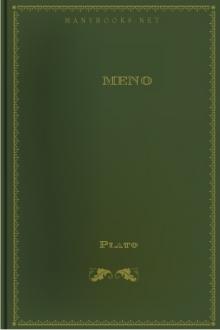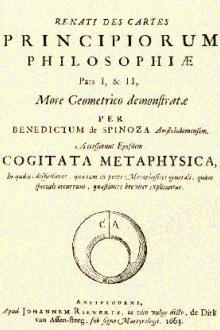The Kama Sutra of Vatsayayana by Sir Richard Francis Burton (phonics readers .txt) 📖

- Author: Sir Richard Francis Burton
- Performer: 1419168118
Book online «The Kama Sutra of Vatsayayana by Sir Richard Francis Burton (phonics readers .txt) 📖». Author Sir Richard Francis Burton
‘The fall of the semen of the man takes place only at the end of coition, while the semen of the woman falls continually, and after the semen of both has all fallen away then they wish for the discontinuance of coition.’ 2
Lastly, Vatsyayana is of opinion that the semen of the female falls in the same way as that of the male.
Now some may ask here: If men and women are beings of the same kind, and are engaged in bringing about the same results, why should they have different works to do?
Vatsya says that this is so, because the ways of working as well as the consciousness of pleasure in men and women are different. The difference in the ways of working, by which men are the actors, and women are the persons acted upon, is owing to the nature of the male and the female, otherwise the actor would be sometimes the person acted upon, and vice versa. And from this difference in the ways of working follows the difference in the consciousness of pleasure, for a man thinks, ‘this woman is united with me’, and a woman thinks, ‘I am united with this man’.
It may be said that, if the ways of working in men and women are different, why should not there be a difference, even in the pleasure they feel, and which is the result of those ways.
But this objection is groundless, for, the person acting and the person acted upon being of different kinds, there is a reason for the difference in their ways of working; but there is no reason for any difference in the pleasure they feel, because they both naturally derive pleasure from the act they perform. 3
On this again some may say that when different persons are engaged in doing the same work, we find that they accomplish the same end or purpose; while, on the contrary, in the case of men and women we find that each of them accomplishes his or her own end separately, and this is inconsistent. But this is a mistake, for we find that sometimes two things are done at the same time, as for instance in the fighting of rams, both the rams receive the shock at the same time on their heads. Again, in throwing one wood apple against another, and also in a fight or struggle of wrestlers. If it be said that in these cases the things employed are of the same kind, it is answered that even in the case of men and women, the nature of the two persons is the same. And as the difference in their ways of working arises from the difference of their conformation only, it follows that men experience the same kind of pleasure as women do.
There is also a verse on this subject as follows:
‘Men and women, being of the same nature, feel the same kind of pleasure, and therefore a man should marry such a woman as will love him ever afterwards.’
The pleasure of men and women being thus proved to be of the same kind, it follows that, in regard to time, there are nine kinds of sexual intercourse, in the same way as there are nine kinds, according to the force of passion.
There being thus nine kinds of union with regard to dimensions, force of passion, and time, respectively, by making combinations of them, innumerable kinds of union would be produced. Therefore in each particular kind of sexual union, men should use such means as they may think suitable for the occasion. 4
At the first time of sexual union the passion of the male is intense, and his time is short, but in subsequent unions on the same day the reverse of this is the case. With the female, however, it is the contrary, for at the first time her passion is weak, and then her time long, but on subsequent occasions on the same day, her passion is intense and her time short, until her passion is satisfied.
On the different Kind of Love
Men learned in the humanities are of opinion that love is of four kinds:
Love acquired by continual habit
Love resulting from the imagination
Love resulting from belief
Love resulting from the perception of external objects
Love resulting from the constant and continual performance of some act is called love acquired by constant practice and habit, as for instance the love of sexual intercourse, the love of hunting, the love of drinking, the love of gambling, etc., etc.
Love which is felt for things to which we are not habituated, and which proceeds entirely from ideas, is called love resulting from imagination, as for instance that love which some men and women and eunuchs feel for the Auparishtaka or mouth congress, and that which is felt by all for such things as embracing, kissing, etc., etc.
The love which is mutual on both sides, and proved to be true, when each looks upon the other as his or her very own, such is called love resulting from belief by the learned.
The love resulting from the perception of external objects is quite evident and well known to the world. because the pleasure which it affords is superior to the pleasure of the other kinds of love, which exists only for its sake.
What has been said in this chapter upon the subject of sexual union is sufficient for the learned; but for the edification of the ignorant, the same will now be treated of at length and in detail.
Footnotes
1 High unions are said to be better than low ones, for in the former it is possible for the male to satisfy his own passion without injuring the female, while in the latter it is difficult for the female to be satisfied by any means.
2 The strength of passion with women varies a great deal, some being easily satisfied, and others eager and willing to go on for a long time. To satisfy these last thoroughly a man must have recourse to art. It is certain that a fluid flows from the woman in larger or smaller quantities, but her satisfaction is not complete until she has experienced the ‘spasme g�n�tique’, as described in a French work recently published and called Brevaire as l’Amour Experimental par le Dr Jules Guyot.
3 This is a long dissertation very common among Sanscrit authors, both when writing and talking socially. They start certain propositions, and then argue for and against them. What it is presumed the author means is that, though both men and women derive pleasure from the act of coition, the way it is produced is brought about by different means, each individual performing his own work in the matter, irrespective of the other, and each deriving individually their own consciousness of pleasure from the act they perform. There is a difference in the work that each does, and a difference in the consciousness of pleasure that each has, but no difference in the pleasure they feel, for each feels that pleasure to a greater or lesser degree.
4 This paragraph should be particularly noted, for it specially applies to married men and their wives. So many men utterly ignore the feelings of the women, and never pay the slightest attention to the passion of the latter. To understand the subject thoroughly, it is absolutely necessary to study it, and then a person will know that, as dough is prepared for baking, so must a woman be prepared for sexual intercourse, if she is to derive satisfaction from it.
THIS part of the Kama Shastra, which treats of sexual union, is also called ‘Sixty-four’ (Chatushshashti). Some old authors say that it is called so, because it contains sixty-four chapters. Others are of opinion that the author of this part being a person named Panchala, and the person who recited the part of the Rig Veda called Dashatapa, which contains sixty-four verses, being also called Panchala, the name ‘sixty-four’ has been given to the part of the work in honour of the Rig Vedas. The followers of Babhravya say on the other hand that this part contains eight subjects, viz. the embrace, kissing, scratching with the nails or fingers, biting, lying down, making various sounds, playing the part of a man, and the Auparishtaka, or mouth congress. Each of these subjects being of eight kinds, and eight multiplied by eight being sixty-four, this part is therefore named ‘sixty-four’. But Vatsyayana affirms that as this part contains also the following subjects, viz. striking, crying, the acts of a man during congress, the various kinds of congress, and other subjects, the name ‘sixty-four’ is given to it only accidentally. As, for instance, we say this tree is ‘Saptaparna’, or seven-leaved, this offering of rice is ‘Panchavarna’, or five-coloured, but the tree has not seven leaves, neither has the rice five colours.
However the part sixty-four is now treated of, and the embrace, being the first subject, will now be considered.
Now the embrace which indicates the mutual love of a man and woman who have come together is of four kinds:
Touching
Rubbing
Piercing
Pressing
The action in each case is denoted by the meaning of the word which stands for it.
When a man under some pretext or other goes in front or alongside of a woman and touches her body with his own, it is called the ‘touching embrace’.
When a woman in a lonely place bends down, as if to pick up something, and pierces, as it were, a man sitting or standing, with her breasts, and the man in return takes hold of them, it is called a ‘piercing embrace’.
The above two kinds of embrace take place only between persons who do not, as yet, speak freely with each other.
When two lovers are walking slowly together, either in the dark, or in a place of public resort, or in a lonely place, and rub their bodies against each other, it is called a ‘rubbing embrace’.
When on the above occasion one of them presses the other’s body forcibly against a wall or pillar, it is called a ‘pressing embrace’.
These two last embraces are peculiar to those who know the intentions of each other.
At the time of the meeting the four following kinds of embrace are used:
Jataveshtitaka, or the twining of a creeper.
Vrikshadhirudhaka, or climbing a tree.
Tila-Tandulaka, or the mixture of sesamum seed with rice.
Kshiraniraka, or milk and water embrace.
When a woman, clinging to a man as a creeper twines round a tree, bends his head down to hers with the desire of kissing him and slightly makes the sound of sut sut, embraces him, and looks lovingly towards him, it is called an embrace like the ‘twining of a creeper’.
When a woman, having placed one of her feet on the foot of her lover, and the other on one of his thighs, passes one of her arms round his back, and the other on his shoulders, makes slightly the sounds of singing and cooing, and wishes, as it were, to climb up him in order to have a kiss, it is called an embrace like the ‘climbing of a tree’.
These two kinds of embrace take place when the lover is standing.
When lovers lie on





Comments (0)